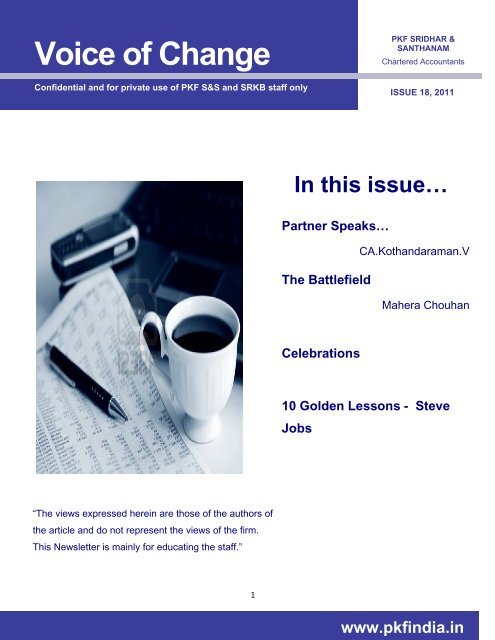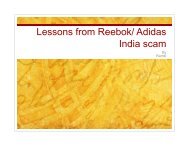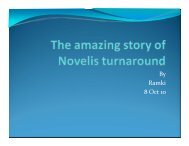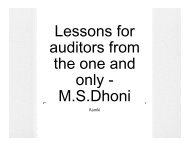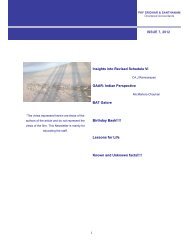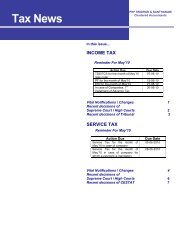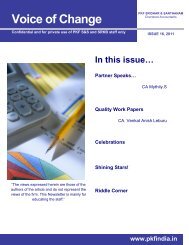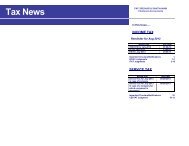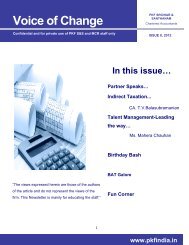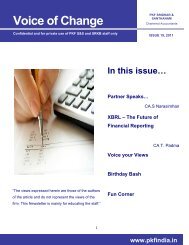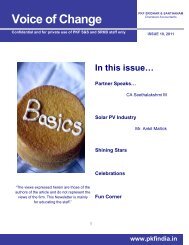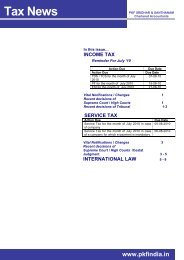Newsletter Issue No 18-15th October 2011 - PKF Sridhar ...
Newsletter Issue No 18-15th October 2011 - PKF Sridhar ...
Newsletter Issue No 18-15th October 2011 - PKF Sridhar ...
- No tags were found...
You also want an ePaper? Increase the reach of your titles
YUMPU automatically turns print PDFs into web optimized ePapers that Google loves.
Voice of Change<strong>PKF</strong> SRIDHAR &SANTHANAMChartered AccountantsConfidential and for private use of <strong>PKF</strong> S&S and SRKB staff onlyISSUE <strong>18</strong>, <strong>2011</strong>In this issue…Partner Speaks…The BattlefieldCA.Kothandaraman.VMahera ChouhanCelebrations10 Golden Lessons - SteveJobs“The views expressed herein are those of the authors ofthe article and do not represent the views of the firm.This <strong>Newsletter</strong> is mainly for educating the staff.”1www.pkfindia.in
<strong>PKF</strong>SRIDHAR & SANTHANAMChartered AccountantsPartner SpeaksCA.Kothandaraman.Vkots@pkfindia.inDear Friends,Swami Vivekananda says “Allpower is within you. You can doanything and everything with it.Believe in that.”Life is full of challenges. Eachone of us has an exquisite powerwithin us to face the challenges.Each one of us can have asignificant impact on the worldaround us – if we so choose. Butfor this power that residesinternally to grow, we need to useit. The more we exercise it, thestronger it gets. The more thispower gets tapped, the moreconfident we become.Human beings haveunquestionable ability to elevatetheir life by conscious endeavor.It is always possible to transcendor go beyond the present statusquo.As we live our days, so we craftour life. Our days are our life inminiature. What we do today isactually creating our future. Thewords we speak, the thoughts wethink, the food we eat and theactions we take are defining ourdestiny - shaping who we arebecoming and what our life willstand for. Small choices lead togiant consequences, over time.There's no such thing as anunimportant day.<strong>No</strong> one ever attains very eminentsuccess by simply doing what isrequired of him; it is the amountand excellence of what is overand above the required thatdetermines the greatness ofultimate distinction.One of the most importantprinciples of success isdeveloping the habit of going theextra mile. In our terminology wecall it as “Value addition to theclient”. A simple vanilla audit mayonly serve the statutory purposebut may not add significant valueto the client. Whatever be the2scope of the engagement, thinkwithin that scope, how to addvalue to the client – It could be byway of controls improvement orcould be by way of saving costswhich improve the bottom line orbenchmarking with bestpractices.For instance, we are notexpected to have engineeringcapabilities, so we generally relyon technical department’scertification for technical matters.While checking a contractor’s billin one of the constructionprojects, the auditor questionedhow the volume of fireproofquoting is significantly highercompared to the metal trussesused. This was simply possiblebecause the auditor corroboratedthe steel purchases bill with thefireproof quoting bill. With theresult, the auditor could detectexcess billing by the contractor.The client was extremely happyas we could detect excess billingdespite the certification of the billwww.pkfindia.in
<strong>PKF</strong>SRIDHAR & SANTHANAMChartered Accountantsby technical, Commercial andfinance departments. While thisis simple common sense, thecorroborative checks carried outby the auditor was certainly an“EXTRA MILE” which resulted incost savings to the client.and that is what your employerrewards.* Be consistent* Do a great job – in fact, do afantastic job!* Do more than expected – gothe EXTRA mile!Don't be content with doing onlyyour duty. Do more than yourduty. It's the horse that finishes aneck ahead wins the race.The best among us are not moregifted than the rest. They justtake little steps each day as theymarch toward their biggest life.And the days slip into weeks, theweeks into months and beforethey know it, they arrive at aplace called Extraordinary.Moral of the story: “GO THEEXTRA MILE”Don’t do a good job, do aFABULOUS job!Your consistent behavior in yourlife translates into excellence,RegardsKots(Ramki PS: Remember Wow!“Do whatever you dodifferently or add a little extrato what you do”)3www.pkfindia.in
<strong>PKF</strong>SRIDHAR & SANTHANAMChartered AccountantsThe BattlefieldMs.Mahera Chouhanmahera.c@pkfindia.inAfter having comprehended theBlack Dragon i.e. the carbonemissions and the Warrior todefeat it- is the carbon credit.The battlefield for the carboncredits to beat the everincreasing carbon emissions isthe carbon market.The carbon market is a conceptbased on “polluter pays” and capand trade principle. The objectiveis to reduce gas emissionsthrough the use of market law.When the companies are listed,the administration decides on thetotal amount of gas emissionsthey can emit as a group.<strong>No</strong>rmally the total amount islower than the one emitted theprevious year. The main ideahere is to reduce this level everyyear.After the central administrationdecides on the total amount, aspecific amount of gas emissionsis distributed to each company.During the year, if a companymanages to emit less than theallowable amount, it can sell theremainder to another company.This transaction doesn’t changethe total emissions of the group.Therefore, one company mustemit a lower-than-allowableamount in order for anothercompany to emit more.This procedure encouragescompanies to make changes inorder to reduce their gasemissions and respect theirallotted amount. The companieswho surpass their allowableemissions must pay for thesurplus by buying more permits.Another important aspect is thatit encourages companies to emitless in order to acquire extraprofit by selling their right topollute.Many people still think of carbontrading as a simple processwhereby offset providers withcredits to sell, or companies with4too many or too few permits,trade with each other directly.However, the carbon market hasdeepened or maturedsignificantly over the years,adding a wide variety of buyersand sellers to the original marketparticipants and introducing abroad range of financial products.These include carbon forwards,futures and options contracts,and carbon indices.Transactions: Kinds & TypesThe simplest transactions in thecarbon market consist ofexchanging carbon permits oroffset credits for cash: this isknown as spot trading becausethe agreed exchange takes place‘on the spot’ (in fact usuallybetween one and three days ofthe price being agreed). Spottrading is relatively risk-free forthose involved in the transaction,as parties are unlikely to defaulton payments over such a shortperiod of time.www.pkfindia.in
<strong>PKF</strong>SRIDHAR & SANTHANAMChartered AccountantsCarbon credits are also traded inthe form of derivatives. It istraded in the form of forwards,futures and options.Futures are closely related toforwards in that the buyer andseller agree to exchange theassets for cash on the maturitydate. The difference is thatfutures are traded through anexchange, meaning that termsand conditions are set bywhichever futures contract isoffered by that exchange.Although a future is a bilateralagreement between two parties,as long as they are registered totrade on the exchange, partiesdo not need to know anythingabout each other.By contrast, forwards are tradedbetween parties known to eachother but where little informationis made public about the trade.Typically, forwards have longermaturity dates than futures,which tend to be limited to theshort to medium term. In thecarbon market, futures arebought and sold on an exchangesuch as the European ClimateExchange, while forwards aretraded over the counter. Both canbe traded by investors andemitters alike.Options allow one of the partiesto pay an up-front fee for theinclusion of a get-out clause inthe carbon trading contract. In anoption there is a fee-payer and afee-taker. The fee-taker isobliged to fulfill the contract; thefee-payer is not.In the carbon market, options aretraded between emitters orspeculators and dealers such asinvestment banks.A swap is an agreement betweentwo parties to exchange thedifference between two prices ofa fixed quantity of a commodityat periodic intervals.Typically the exchange is thedifference between a fixed price(determined at the trade date)and the spot price of thecommodity at periodic intervals.5Carbon credits are traded in theform of derivatives in one or bothof the following ways:• Traded on exchanges: Whilean exchange functions muchlike a club, with a paid-upmembership. Those involved inexchange trading, for example,have to provide evidence ofsolvency and a minimum levelof standards relating totransparency. An exchangealso attempts to reduce the riskof trading failure by makingsure buyers and sellers keepmoney on account (called amargin) in order to cover anypotential losses.• OTC Trading: It is thefavoured method of tradingfor a significant portion ofthe carbon market,although the percentage ofOTC trading is declining infavour of transactions onexchanges. OTC tradingoccurs when derivativesare bought and soldbetween two parties, oftenwww.pkfindia.in
<strong>PKF</strong>SRIDHAR & SANTHANAMChartered Accountantsthrough an investmentbank.The Green AlliesCompanies and governmentswho are aparty to theKyotoProtocol areeligible tomeet the capas set by the protocol.Companies or governmentscovered by a cap and tradescheme use trading to managethe costs of their compliance withthe cap on their emissions. Theytrade with the aim of minimizingcosts by maximizing profits fromcarbon assets (permits received),and by trying to predict futureprices of permits and credits.Speculators aim to make a profitfrom price volatility while othertraders focus on offeringcompanies the chance to pay afee to protect them from pricevolatility.Two BattlefieldsThe carbon market is classifiedinto Primary Markets &secondary Markets.In the primary market, marketparticipants buy carbon creditsfrom original project-owners,often before the offset credits arevalidated. For emissions permitssuch as the EU ETS allowances,the primary market is the initialgovernment auction ordistribution of permits. Forcredits, a common example of aprimary market transaction is anERPA between a CDM projectdeveloper and a credit buyersuch as the World BankPrototype Carbon Fund or thecarbon desk at, say, GoldmanSachs. The buyer may use orretire the credit, or sell the creditto another party.If the buyer resells the CDMcredit to another party, thistransaction occurs in thesecondary market. Similarly, ifan entity acquires a permit atgovernment auction and later6sells it, this too is referred to astrading in the secondary market.Generally, if a carbon credit ispurchased from someone otherthan the original projectdeveloper, the trade is done inthe secondary market. Asecondary CDM offset credit canbe traded between marketparticipants before or after it hasactually been issued.Credits bought in the primaryoffset market and credits that aretraded in the secondary marketbefore being issued are relativelyrisky because of the possibilitythat the project will not deliver theprojected volume of credits.Several specialist companiesnow offer ‘project ratings’,ranging from AAA to ‘junk’, onthe CDM projects from which theoffset credits originate. Factorssuch as the type of project, thestage of the approval process theproject is in, and the countrywhere the project is located, allwww.pkfindia.in
<strong>PKF</strong>SRIDHAR & SANTHANAMChartered Accountantsaffect the ‘delivery risk’ of aproject and the offset credits, and(EUAs). The EUAs accounted for84% of global carbon market.objectivesisSource: World BankState and Trends ofCarbon Market <strong>2011</strong>therefore its rating. For example,With the value of the secondaryminimizedcompared with wind projects,CDM transactions taken intothrough anhydropower projects have aaccount, the share of the carboneffectivelower and slower approval ratemarket primarily driven by the EUuseofby the CDM Executive Board,Emissions Trading Schemetrading.and are generally rated as riskier.Therefore different offset projectsin the primary market canpromise an equal amount ofcarbon reductions, but commandvery different prices for theircredits.The carbon market is currentlyvalued at $142 million by theWorld Bank’s annual report of theCarbon Market in June <strong>2011</strong>.The current market displays thesheer dominance of theEuropean Union Allowance(EUETS) rose to 97 percent,dwarfing the remaining segmentsof the market.<strong>No</strong>w that, the carbon marketshave displayed immensepotential for growth anddevelopment, it is worthwhile tounderstand what process andwhat justifications do companiesall over the globe follow beforeentering this market. Forexample, cost consciouscompanies will want to ensurethat the cost of meeting emission7How would acompany makeits decisions —whether to tradeor not to trade,whether toproduce andhow much,whether to invest, and in what?The following figure is a stylizedand simplified, attempt to chartthese questions through adecision tree, focusing on thenear term. Starting with a simplequestion — are emissions abovetarget? —companies would needto evaluate their options asbuyers or sellers.Source: World Bank State and Trends ofCarbon Market <strong>2011</strong>www.pkfindia.in
<strong>PKF</strong>SRIDHAR & SANTHANAMChartered AccountantsThe AmmunitionThrough carbon offsets and theCleanDevelopmentMechanism, helping theenvironment has not onlybecome quantifiable, it’sbecome an asset that can bebought and sold. This presentsfinancial opportunities forcompanies, governments and,importantly investors.Once a project has beenaccredited and issued CERs, itcan then sell its credits on atrading scheme.Official research and projectionsfrom the United NationsFramework Convention forClimate Change indicate that thetrading schemes are tradingstrongly, and demand for creditsis exceeding supply byapproximately 249.6 Mt of CO2every year (UNFCC, 2009). Themap below shows the position ofindustrialised countries andwhether they are buyers ofcredits. The map demonstratesthat most of Western Europe,Australia and the USA are netbuyers of credits.There are a number of reasonsbehind the purchase of carboncredits:• Purchase of low costemission reductions asinvestmentsCredit prices are forecast tocontinue to increase. Savvyinvestors who buy now areexpected to sell their credits at amuch higher price in the future.8• Risk-diversificationA number of buyers arepurchasing different types ofcredits under all of the tradingmechanisms in order to spreadrisk across a portfolio.• Good publicitySome buyers, particularly largecompanies and governments, arepurchasing credits in order todemonstrate that they arecontributing to sustainabledevelopment and are concernedabout the future of the globalenvironment.The map depicts countriesbuying carbon credits during2010-11.Credits are quoted in Euros (€) orUS Dollars (US$) for sale on theglobal market. Factors affectingcredit prices include:Market priceIn the majority of cases, thevalue of credits is benchmarkedto the European Union EmissionAllowance (EUA), the mostwww.pkfindia.in
<strong>PKF</strong>SRIDHAR & SANTHANAMChartered Accountantsestablished trading system. It istherefore important to have astrong understanding of theunderlying market dynamics ofthe EUA.CreditPrice negotiations can oftendepend on the credit worthinessof buyers and sellers i.e. projectsoperated by developing countriesmay offer lower prices as credit ismore risky. Alternatively, projectsrun in a developing country butoperated from the UK often sellfor higher prices.Terms and conditions of saleIf the seller offers deliveryguarantees, uses of establishedmethodology or if they bear thecost of developing thedocumentation then premiumprices can be negotiatedRiskLike any investment, the level ofrisk can significantly alter theprice. This may include sovereignrisk i.e. is the project located in apolitically unstable country? OrQuality risk i.e. is the projectdeveloped to standards such asthe CDM Gold Standard? Anddelivery risk i.e. is thereguarantees if the project fails togenerate the expected volumesof emissions reductions.Stage of project developmentThe more developed a project, interms of approvals anddocumentation as well asphysical construction, the lesslikely it is (in theory) to fail ingenerating credits. Thereforeprices tend to be set higher.Access to marketGenerally, a wider access tomarket results in higher bids,due to the competitive nature ofbuyers. For this reason, goingthrough a credit broker might beattractive to both buyers andsellers. Buyers get the benefitof convenience, quality andrange of access to projects, andsellers the benefit of the broadnetwork of buyers this exposesthem to.9Exchanges and FundsThe World Bank currently has 10carbon funds, with 16governments and 66 participatingfirms.They are enumeratedas under:Prototype Carbonfund: Pioneering KyotoMechanisms since2000.Community DevelopmentCarbon fund: Focused on smallprojects that measurably benefitthepoorcommunities.Bio Carbon Fund: Focused onland –use, land-use change andforestry projectsUmbrella CarbonFacility-Tranche-1:Focused on twoChina HFC23 projects.Netherland CDM Facility Fund:www.pkfindia.in
<strong>PKF</strong>SRIDHAR & SANTHANAMChartered AccountantsThe DutchGovernmentsupportsprojects indevelopingcountries and in countries witheconomies in transition thatgenerate greenhouse gasemission reductions.Netherlands European CarbonFacility Fund:Focuses onpurchase greenhouse gasemission reductions for thebenefit of the Netherlands. TheFacility purchases emissionreductions from JI projects only,i.e. from projects located incountries with economies intransition.Spanish carbon Fund:The SCF aims atpromoting the useof cleanertechnologies and sustainabledevelopment in developingcountries and countries witheconomies in transition. The SCFis also looking for technologicaldiversity in its portfolio includingprojects with astrongsustainable developmentcomponent.Italian Carbon Fund: The aim ofthe fund is to support andpurchase carbon credits from theuse of the project based flexiblemechanisms. The Fund is opento the participation of Italianprivate and public sector entities.Danish Carbon Fund: The DCFis open to considering CDMprojects throughout thedeveloping world and as suchtreats all regions equally. TheDCF has also adopted apragmatic and flexible approachwith respect to the technologiesthat is considered as part of theproject portfolio. However, apreference for projects in thearea of wind power, combinedheat and power, hydropower,biomass and landfills.European Carbon Fund: TheECF identifies potential carboncredits in developing or transitioncountries - Latin America, Asia,Eastern Europe, Middle East andAfrica. Various technologies canbe applied, e.g. renewableenergy, energy efficiency, wastemanagement, and sustainableindustrial process.Final WordAs per Carbon EmissionsTrading Market 2010, by the endof 2013, the total valuetransacted in the carbon marketsis projected to reach US$669billion, making it one of thebiggest growth stories ininvestmentToday’s infrastructure choiceswill affect countries’ energyprofiles for the next few decades,when even more significantreductions may be called for. Aclear signal today could avoid thefuture cost of changing course.International emission tradingcan deliver that signal.10www.pkfindia.in
<strong>PKF</strong>SRIDHAR & SANTHANAMChartered AccountantsBirthday Bash!!!!!S.noNameDate OfBirthBranch1 BALAJI. C 8‐Oct Chennai2 RAJAGOPAL. G 14‐Oct Chennai3 KRITHIKA .P.N 10‐Oct Chennai4 MEENAKSHI SUNDARAM 6‐Oct Chennai5 SURESH KUMAR RAJU B 13‐Oct Hyderabad6 PRADEEP G 23‐Oct Chennai7 ANAND SUBRAMANIAN H 30‐Oct Chennai8 NITIN B JAIN 21‐Oct Chennai9 GANGALAKSHMI 22‐Oct Chennai11www.pkfindia.in
<strong>PKF</strong>SRIDHAR & SANTHANAMChartered Accountants10 Golden lessons – Steve Jobs• “Innovation distinguishes between a leader and a follower.”• “Be a yardstick of quality. Some people aren’t used to an environment where excellence is expected.• “The only way to do great work is to love what you do. If you haven’t found it yet, keep looking. Don’tsettle. As with all matters of the heart, you’ll know when you find it.”• “You know, we don’t grow most of the food we eat. We wear clothes other people make. We speak alanguage that other people developed. We use a mathematics that other people evolved… I mean, we’reconstantly taking things. It’s a wonderful, ecstatic feeling to create something that puts it back in the pool ofhuman experience and knowledge.”• “There’s a phrase in Buddhism, ‘Beginner’s mind.’ It’s wonderful to have a beginner’s mind.”• “We think basically you watch television to turn your brain off, and you work on your computer when youwant to turn your brain on.”• “I’m the only person I know that’s lost a quarter of a billion dollars in one year…. It’s very character-building.”• “I would trade all of my technology for an afternoon with Socrates.”• “We’re here to put a dent in the universe. Otherwise why else even be here?”• “Your time is limited, so don’t waste it living someone else’s life. Don’t be trapped by dogma – which is livingwith the results of other people’s thinking. Don’t let the noise of other’s opinions drown out your own innervoice. And most important, have the courage to follow your heart and intuition. They somehow already knowwhat you truly want to become. Everything else is secondary.”12www.pkfindia.in
<strong>PKF</strong>SRIDHAR & SANTHANAMChartered AccountantsFacts of Steve JobsSteve Jobs was born in 1955 and was adopted by Paul and Clara Jobs.Jobs actually worked for Atari in early 1974, during which he saved up money to travel to India and searchfor spiritual enlightenment.After receiving an order for 25 Apple I computers, Jobs and Wozniak raised needed capital by selling Jobs'Volkswagen van and Wozniak's Hewlett-Packard scientific calculator.Jobs and Wozniak actually offered the very first Apple computer to HP in 1976; however nobody at HP wasinterested!Again in 1976, Jobs and "Woz" approach another company, Commodore, about purchasing their productbecause they did not have the funds to produce it in large quantities. Again they are turned down!!In early 1985, there was a huge power struggle at Apple, and Jobs is stripped of all his authority, althoughhe still remains the Chairman. Later that year, Steve Jobs stood up in an Apple board meeting and said in aflay, unemotional voice, "I've been thinking a lot and it's time for me to get on with my life. It's obvious thatI've got to do something. I'm thirty years old." He would not return to Apple until 1997!In recognition of his pioneering work in technology, he was awarded the National Technology Medal byPresident Reagan in 1985 and the Jefferson Award for Public Service in 1987. In 1989, he was namedEntrepreneur of the Decade by Inc. magazine.13www.pkfindia.in
<strong>PKF</strong>SRIDHAR & SANTHANAMChartered AccountantsJobs purchased the Pixar Animation Studio from George Lucas for $10 million in 1986.At one point during Jobs career, his net worth jumped by $2.8 billion in one year!Apple Stock Holdings: <strong>No</strong>w owns only a symbolic one share; he's paid $1 a year from Apple so that he canbe on the health plan.(Ramki PS: It is like losing a friend. He creates a void, which cannot be filled easily.)14www.pkfindia.in


